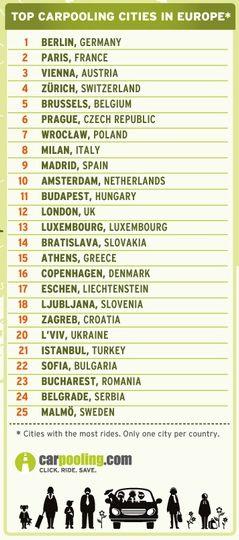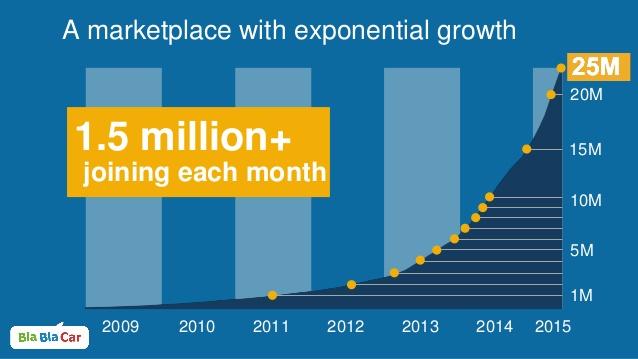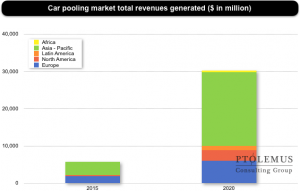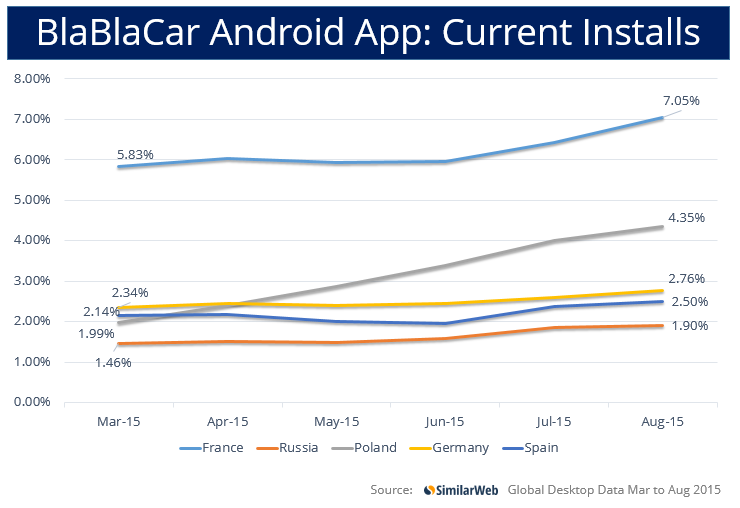Business Definition
BlaBlaCar is a European online carpooling service that helps in finding a travel companion. Its customers are drivers who want to save on the ride expenses and people who seek cheap travel means. The web service matches the offerings from car owners with the passengers’ searches and allows finding a desirable ride based on feedback from previous customers and companion’s preferences, such as music tastes and desire to talk during the trip. In recent years, the company managed to expand its operations across Europe and was recently introduced in Asia. The following paper analyzes global strategy levers and industry globalization drives to determine the company’s international strategy.
Key Markets and Competitors
BlaBlaCar operates as a substitute for traditional transportation services. However, since it does not provide its customers with profit generation opportunities, it targets a wider audience than most of its counterparts. It covers two distinct markets. First, it reaches out to the customers who seek an alternative to a traditional means of travel, such as a railroad or a commercial flight. BlaBlaCar’s main advantage in the field is its price, which is more affordable compared even to the cheaper means of transportation. However, the services it offers also provide the clients with an opportunity to choose a more suitable option, either in terms of physical convenience or the one which has social or psychological advantages (e.g. a companion which shares the desire to stay silent during a trip). The second key market is comprised of car owners who look for ways to minimize the cost of their ride. Importantly, the savings occur on a cost-sharing basis, which does not generate revenues and covers only the expenses which would occur anyway. This fact greatly expands the market from the holders of license for transportation (required in some countries) to virtually all drivers who own a car and wish to participate.
Since carpooling is a relatively established practice, the market is populated with numerous similar services such as Heetch, Ants, flies, Ridejoy, and Together, among many others (Crunchbase). Nevertheless, it should be acknowledged that the majority of these services either emerged or developed based on BlaBlaCar’s successful business strategy, which results in inferior popularity. None of the competitors present a significant threat to BlaBlaCar in terms of revenues, size, or brand name recognition. One of the major competitors, carpooling.com, was recently acquired by BlaBlaCar as a part of its international strategy (Dillet).
It should be noted that dense competition exists mainly on the European market due to a range of factors and is far less prominent in the U.S. Therefore, the U.S.-based company Uber, which exceeds BlaBlaCar in most parameters, is often named its key competitor. However, Uber operates under a different business model and scale, focuses on short trips, and, most importantly, includes fees for drivers. Therefore, the licensing comes into play, and, as a result, the two companies essentially offer different services, making them incompatible as competitors.
Core Strategy
Throughout its development, the company utilized several strategic thrusts to gain a competitive advantage. First, it incorporated innovation as a core component of its operations. First, it constantly improves its web-based platform to overcome time constraints and logistical issues. This approach allowed it to popularize online car-pooling functionality and is currently responsible for its firm position on the market. To add value to its services, BlaBlaCar seeks partnerships with other companies that offer enhancements to the quality of its services. For instance, in 2015 it partnered with Hewlett-Packard to increase the data processing capacity of its platform (Cairns). The implementation of HP Vertica, a platform provided by the partner, utilizes Big Data analysis to determine behavioral patterns behind customer decisions, which adds to the reliability and precisions of models used in the service. This significantly improves search results for both the drivers and the passengers and increases the likelihood of a successful ride, thereby increasing customer satisfaction. It also can be used for modeling new market entries, providing a more accurate picture of the process.
Another valuable alliance serving as a strategic thrust is the introduction of insurance from AXA. The insurance scheme is designed specifically for long-distance shared trips and covers the costs of issues pertinent for a specific setting, such as the difference in insurance in case an accident occurs while the passenger takes turns with the driver to let the latter rest during a particularly long trip. Also, the passengers are guaranteed to be transported to the destination in the cases when the vehicle becomes inoperable and cannot be restored in a meaningful time frame (Caillet). Essentially, such an approach minimizes the most prominent disadvantages of carpooling and raises the quality bar of BlaBlaCar’s services to a new level.
Finally, the company incorporates attractive pricing policies in its strategy. Since the services do not generate profit in any way, all of the revenues are obtained by charging a percentage of the shared expenses (usually 15 percent). Despite this, the final net value of a ride is still more attractive than that of the nearest alternative. For the newly penetrated markets, BlaBlaCar modifies the model and provides the full functionality of the service for free. This strategy is maintained until the customer base reaches a critical point where it would be possible to retain a segment sufficient for further functioning of the service. Minimized cost of the service contributes to trust and fosters loyalty of the customers and, by extension, adds value to the business.
Country Selection
The company currently offers its services in 22 countries of the world. While BlaBlaCar does not provide the list of countries in official sources, its market is often described as located primarily in Europe. The most recent events marked its expansion beyond the European market to include Brazil, India, Turkey, and Russia. There are several reasons behind such country selection. First, the company tries to target the markets which are familiar with the concept of carpooling, which makes Europe a good place to start. In some forms, ride-sharing services existed in many European countries and even enjoyed moderate support from local authorities such as the allocation of space and construction of stops for passengers. Besides, European gas prices were traditionally higher than those of the U.S., which prompted car owners to seek the possibility of saving. The situation is relatively the same today, which creates ensures the persistent demand for BlaBlaCar’s services. For this reason, the company is still not introduced in the U.S., where the cost of the trip is of less concern to the stakeholders.
The recent expansion of the market to Russia and Ukraine is driven by the latter reason since the audience there is unfamiliar with the practice of ride-sharing. However, both countries have a significantly lower average income per citizen, which further increases the value of services for the target audience (Gao). Finally, both Russia and Ukraine are large countries with a developed infrastructure and relatively unstable transportation system, which leads to high demand for long-distance trips that the company supports with its services. Brazil and India also fall fit well within the described patterns since both are developing countries with a demand for the car ride-sharing services.
It is also worth noting that access to online services and familiarity of the population with various online functions such as e-payments are required for a successful introduction of BlaBlaCar’s services. However, the current rate of development in the IT-sphere allows us to consider this factor secondary since it is unlikely that a market with sufficient demand for the company’s service will not meet this criterion.
Industry Globalization Drivers
Market Drivers
The most evident homogenizing market driver is the emergence of the Internet as a source of information and means of communication. Customers across the world display similar demand for functions of web services and get used to a relatively uniform level of quality. Also, the ubiquity of personal mobile devices capable of Internet access allows BlaBlaCar to introduce its standardized app with little adjustments in each new market. Finally, the feedback and rating system is to be expected by the majority of users since it is present in many key players in the IT industry, further minimizing the need for local adjustments.
Cost Globalization Drivers
The influence of this driver can already be observed on the market in question. As was explained above, the case of BlaBlaCar essentially shaped the online-driven iteration of the market. All of the current companies mimic the company’s approach and rarely introduce unique value, which may be responsible for their relatively modest performance. The situation holds for the markets where the BlaBlaCar has not expanded yet, such as the Middle East. While the setting does not pose significant difficulty for new entrants (mostly because of the low cost of the equipment and staff), the rivalry within the industry grows steadily, which, gives BlaBlaCar a significant advantage due to its unprecedented expansion.
Competitive Drivers
Two major trends must be pointed out regarding the competitive drivers of carpooling services. First, the market is characterized by a high national diversity of competitors, both within Europe and across the world. The latter can be derived from the fact that Asian countries occupy a significant portion of the market and generate profit exceeding that of combined European revenues (Hallauer). The second driver is the globalization of the operations in the European segment by BlaBlaCar, leading to their dominant position. A combination of these drivers creates low competitive diversity in Europe and a much higher one in the Asian region. The rest of the world currently negligible activity and has no significant influence.
Government Drivers
The first driver observed across Europe and in many developed Asian countries is the presence of governmental-regulated licenses required for commercial transportation. This driver is effectively universal and serves as a decisive advantage for BlaBlaCar’s customers who do not engage in commercial activities (Gao). This driver provides the service with a much wider target audience as it includes all car owners. The second important driver is increasing pressure originating from numerous environmental laws and regulations. European market demonstrates the most rigorous approach to the issue, and the Asian segment shows signs of the same pattern. As a result of these regulations, expenses associated with owning a car are expected to rise, prompting the drivers to seek ways of decreasing the cost of long-distance travel. Therefore, governmental drivers are favorable for the service.
Global Strategy Levers
Scope of Participation
BlaBlaCar uses an expansion model of acquiring small-scale carpooling companies to increase its scope, which has led to its presence in 22 countries (Dillet). The company is expected to proceed with the current strategy, eventually reaching out to the Asian and American markets.
Uniformity of Products and Services
The company uses the same services across the world, introducing only minor localization techniques such as translation of apps. The pricing model is scaled relative to fuel prices, which ensures affordability regardless of the average customer incomes.
Location of Activities
The company hires personnel locally, which is consistent with the scalability of revenues and improves the knowledge of local cultural and social specificities. Such an approach is also justified by the online service location, which minimizes the required minimum number of employees.
Marketing Policy
The company emphasizes simplicity and affordability as its cornerstone policies. The service constantly gathers data on customer behavior and introduces adjustments to provide the best experience for the customers. Customer diversification further enhances accessibility for the audience unfamiliar with online services.
Competitive Moves
BlaBlaCar achieves competitive advantage through a customer-centered approach, providing additional services and options to meet their expectations. The interventions range from service engine optimization to gradual integration of functions into car design (Gao).
It should be mentioned that the resulting strategy is closer to the multi-domestic model, although the lack of differences can in all instances be attributed to the online nature of the service, which allows uniformity and standardization.
Introduction to Australia
The Australian ridesharing market is currently in the initial stage of development. Therefore, considering the identified globalization drivers and strategy levers, it would be reasonable to suggest the following it entry model. BlaBlaCar would acquire a small-scale ridesharing service, which would secure the initial inventory and provide a starting point for customer base development. Coseats.com would be a good option due to its visibility and scale. For the first ten months, the company will provide its services for free, subtracting no fees from the transactions made by the customers. The familiarity with the concept of ridesharing is expected to facilitate a quick buildup of the critical mass of customers, so the final months are reserved for strengthening the loyalty of the audience. The cost globalization driver coupled with the presence of uberX service is expected to facilitate stronger commitment thanks to a more attractive pricing model.
Besides, the recent switch of Australian taxi service providers from traditional approaches towards more innovative ones, such as mobile booking applications, will further improve the awareness of the target audience. The marketing policy of efficiency and simplicity can be retained as soon as the rebranding process is finished and BlaBlaCar’s online service is introduced in place of the acquired company. The traditional competitive moves (e.g. insurance of rides) can be incorporated as soon as the partnership conditions with the Australian branch of AXA are established. It is also worth pointing out that government drivers are currently in the process of change in Australia. More specifically, the ongoing regulatory reform has already started reshaping the taxi industry in the mainland states and territories. This arguably offers an additional advantage to the service that does not rely on revenue generation for drivers and is therefore exempt from the majority of the regulations that hamper its main competitor, uberX.
After the passing of ten months, the second phase can commence, during which a standard fee of withholding 15 percent of the transactions. During this phase, it is reasonable to expect the loss of a certain amount of customer base. However, since the pricing is expected to be marginally lower than that of uberX’s services, and significantly lower than that of other nearest alternatives (traditional taxi services), the critical mass of the customer base is expected to be retained and eventually expanded.
Stakeholder Benefits
The introduction of the service to Australia will add value to multiple stakeholders. For car owners, the cost of car maintenance will be significantly reduced considering the observable trends in the prices of gasoline. The passengers will benefit from the introduction of services of superior quality and affordability. Specifically, two features of the service are expected to increase the consumer entry into the market: the low price of the service and the increased number of features offered by BlaBlaCar, such as mutual ranking options and the choice of a ride based on the desired traits of the driver. By extension, the latter may become beneficial for the Australian community by providing better safety and security while involving the interaction of the stakeholders who pursue the same goals. The authorities may benefit from the company’s entry as unlike uberX, BlaBlaCar does not need the adjustment of the regulations or the introduction of new licensing practices. Most importantly, in the long run, such service can be beneficial for environmental agencies, as the trend of increasing environmental regulations suggests the eventual emergence of complications associated with the transportation segment.
Conclusion
Despite the obvious dependence on several major-scale factors, such as fuel prices, BlaBlaCar demonstrates an impressive capacity for international expansion. The uniformity of products and services, appealing sharing economy concept, and policy of simplicity and approachability coupled with a wide array of customers allow us to expect further growth through acquisitions of minor competitors. Asian region remains the most viable direction of expansion in terms of revenues. Australia, which currently undergoes regulatory reform and is already familiar with ridesharing through uberX, can be considered an option, with the gradual shift towards online-based taxi services being an important global strategy lever.
Appendix




Works Cited
Caillet, Helene. “BlaBlaCar and AXA Launch First-of-its-Kind Ridesharing Insurance Product.” AXA, 2015. Web.
Cairns, Randy. “HP Helps BlaBlaCar Improve Customer Experience.” HP, 2014. Web.
Crunchbase. “BlaBlaCar Competitors.” Crunchbase, 2016. Web.
Dillet, Romain. “BlaBlaCar Acquires Its Biggest Competitor Carpooling.com To Dominate European Market.” TechCrunch, 2015. Web.
Gao, Min. “How has a French Car-sharing Company Become Internationally Successful? – Great Examples from Blablacar.” LinkedIn, 2015. Web.
Hallauer, Thomas. “Google set to challenge Uber, Lyft and Didi for control of $30 billion car pooling market.” Ptolemus, 2016. Web.